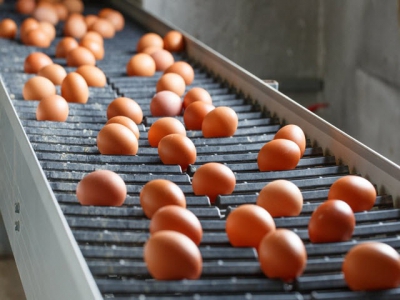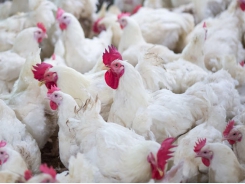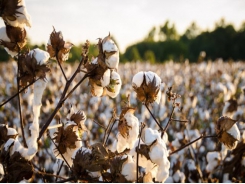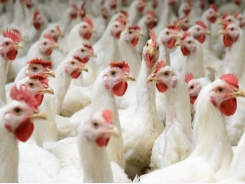Organic manganese additives may improve shell strength, layer performance

Laying hens may display improved production and stronger eggs when levels of amino acid-complexed manganese are added to feeds, say researchers.
Researchers from the US and China explored the long-term use of an organic form of manganese (Mn) in the diets of laying hens. The group published details of its project in the journal, Animal Feed Science and Technology.
“It is meaningful to investigate the effects of long-term dietary Mn supplementation in amino acid-complexed form with a wide range on performance, egg quality, redox status, hematology, plasma biochemical parameter and organ histopathological assessment in laying hens,” the researchers said. “High-dose levels were adopted to explore the limited inclusion of Mn, while other dose levels were set to obtain the appropriate Mn supplemental level in diet of Hy-Line Brown laying hens at age from 23 to 46 wk.”
The team found that adding 80mg/kg of manganese lowered the feed conversion ratio (FCR) and boosted egg production while adding 40mg/kg improved egg production, egg mass and decreased FCR.
Adding more than 20mg/kg of manganese to bird diets improved eggshell strength, they said. Adding 40 or 80mg/kg increased superoxide dismutase (T-SOD,) however, that response declined if more than 120mg/kg were included in the feed.
When 400 and 800mg/kg Mn were added, birds displayed increased white blood cells, platelet and creatinine along with inflammation in kidney tissue, the authors reported.
“Dietary Mn supplementation could increase egg mass, decrease FCR, and improve eggshell breaking strength and redox status of laying hens, with a level of 40 mg/kg from Mn-amino acid complexes,” the researchers said. “More than 400 mg/kg Mn supplementation could cause local inflammation in kidney.”
“These results suggested that dietary amino acid-complexed Mn inclusion at 40 mg/kg could be appropriate, when Hy-Line Brown laying hens were fed a corn-soybean meal basal diet (21.95 mg/kg, Mn) during 23 to 46 wk of age,” they added.
How much manganese is needed in layer diets?
Manganese is an important trace mineral supplemented in feeds for laying hens as a small amount tends to be present in corn-soybean meal diets and birds have poor absorption, the researchers said. The nutrient is involved in bird growth, reproduction, metabolism and clotting.
But there continue to be questions about how much should be included in the diet and published requirements are inconsistent, they said. Information provided by the National Research Council (NRC) stems from studies done 20 years ago and work on laying hen genetics has continued to improve egg production and feed efficiency.
“More work is desirable to evaluate the associated effects of dietary Mn supplementation on the productive performance of laying hens under the updated production systems, and further determine an appropriate Mn inclusion."
Why supplement feed with manganese?
Research with older layers into supplemental Mn found that it could improve eggshell quality, the researchers said. However, eggshell quality remains an issue with younger birds and more information is needed about the influence of Mn supplementation on eggshell quality for birds in the early laying phase.
Manganese plays a role in preventing “radical-mediated oxidative damage” as a factor involved with manganese-containing superoxide dismutase, they said. But, high levels of the nutrient in a cell can boost reactive oxygen species and cause inflammation and oxidative damage.
Attention needs to be paid to the potential negative effects when too much Mn is added to the diet, they said. “Unfortunately, to the best of our knowledge, available data and literature concerning the safety of Mn in laying hens are very limited, and the effects of long-term supplementation with high-dose Mn even have not been seen,” they added.
Supplementing layer feeds with organic Mn rather than inorganic Mn may provide improved absorption and bioavailability, they said.
Feeding trial details
In the trial, 756 21-week old laying hens received one of seven diets for 24 weeks, the researchers said. The experimental feeds were provided following two weeks on a basal diet.
The diets included a control corn and soybean meal-based feed and that diet with varying levels of Mn added at 20, 40, 80, 120, 400 and 800 mg/kg Mn from Mn-amino acid complexes, they said.
Eggs weight, production and mortality were documented daily by replicate and feed consumption noted every 4 weeks, they said. Egg mass, feed conversion ratio (FCR) and average daily feed intake (ADFI) were calculated.
A selection of eggs was gathered for quality evaluation every four weeks and egg specific gravity along with the eggshell thickness and breaking strength were noted, the researchers said. Albumen height, yolk color and Haugh unit were assessed.
Blood, serum and plasma samples were gathered on week 24 and analyzed for components including total superoxide dismutase (T-SOD), copper and zinc-containing superoxide dismutase (Cu, Zn-SOD), manganese-containing superoxide dismutase (Mn-SOD), red blood cells (RBC), white blood cell (WBC) hematocrit, hemoglobin, platelets, total bilirubin (TB), glucose, total protein (TP), albumin, uric acid (UA) creatinine alkaline phosphatase (ALP), alanine aminotransferase (ALT), and aspartate aminotransferase (AST), they said.
Bird tibias were checked for calcium and Mn levels, they said. Histopathological assessments were done.
Results
Adding supplemental Mn lowered egg weight and increased egg mass during the trial, the researchers said. ADFI fell linearly and quadratically during the first 12 weeks and tended to decrease during the rest of the feeding trial.
Average egg weight declined in birds receiving more than 20mg/kg Mn during the latter half of the feeding trial and for birds getting more than 120mg/kg Mn for the entire feeding trial, they said. Birds eating feeds with more than 80mg/kg Mn saw feed intake decline during the first 12 weeks.
“Compared with the basal diet (control), dietary supplementation with Mn at level of 80 mg/kg increased egg production and decreased FCR during 1–12 and 1–24 wk,” they said. “Manganese supplementation at 40 mg/kg increased egg production (1–12, 13–24 and 1–24 wk), egg mass (13–24 and 1–24 wk), and decreased FCR (13–24 and 1–24 wk.”
There were no differences in albumen height, yolk color, egg specific gravity Haugh units, eggshell thickness or proportion at the end of the test, but eggshell breaking point had a linear response to feed supplementation, they said.
Similarly, there were no changes to “hematocrit, RBC, hemoglobin, TB, glucose, TP, albumin, globulin and UA, and the activities of AST, ALT, ALP and Cu, Zn-SOD,” the researchers said. WBC, platelet and creatinine increased as did Mn-SOD and T-SOD activity.
“Higher values of WBC, platelet and creatinine were found in the Mn added groups of 400 and 800 mg/kg diet; meanwhile supplementation ≤120 mg/kg Mn had no adverse effects on hematology and plasma biochemistry,” they added.
Higher Mn contents were found in the tibia of birds on the supplemented diets, they said. But bodyweight, organ index, tibia strength and Ca levels were similar for all diets and there was some local inflammation in the kidney tissue of birds receiving 400 and 800mg/kg Mn but not for other birds.
“Dietary supplementation with Mn can improve productive performance, eggshell breaking strength and redox status, at a level of 40 mg/kg from Mn-amino acid complexes,” the researchers said. “Overdose of Mn supplementation (≥ 400 mg/kg) would cause detrimental effects to Hy-Line Brown laying hens.”
Source: Animal Feed Science and Technology
Authors: Y. Cui, H. Zhang, J. Zhou, S. Wu, C. Zhang, G. Qi, J. Wang
Có thể bạn quan tâm
Phần mềm

Phối trộn thức ăn chăn nuôi

Pha dung dịch thủy canh

Định mức cho tôm ăn

Phối trộn phân bón NPK

Xác định tỷ lệ tôm sống

Chuyển đổi đơn vị phân bón

Xác định công suất sục khí

Chuyển đổi đơn vị tôm

Tính diện tích nhà kính

Tính thể tích ao hồ




 Poultry, egg conference covers animal welfare, sustainability trends
Poultry, egg conference covers animal welfare, sustainability trends  New poultry learning center showcases animal care
New poultry learning center showcases animal care